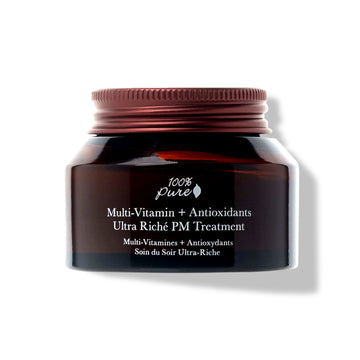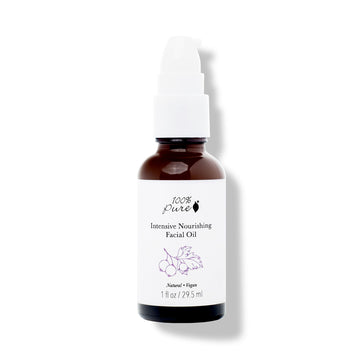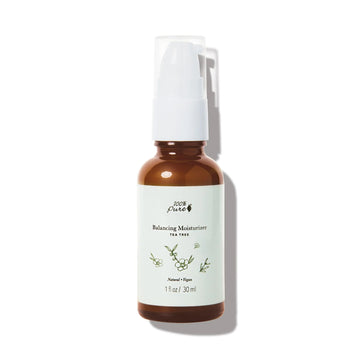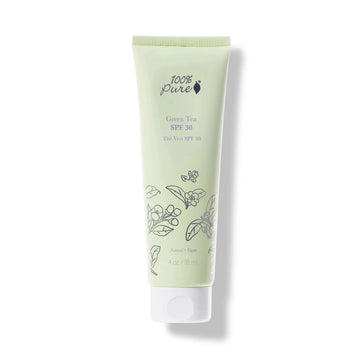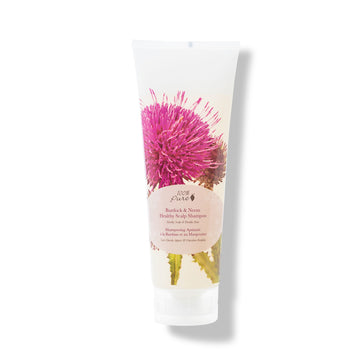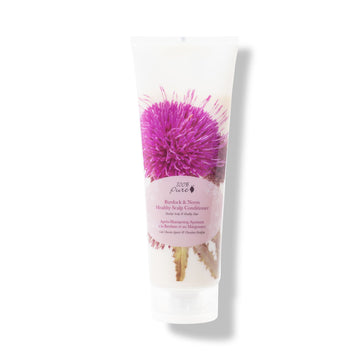Exploring the Comedogenic Scale and What “Non Comedogenic” Actually Means
Posted on January 7, 2025 Written by: 100% PURE®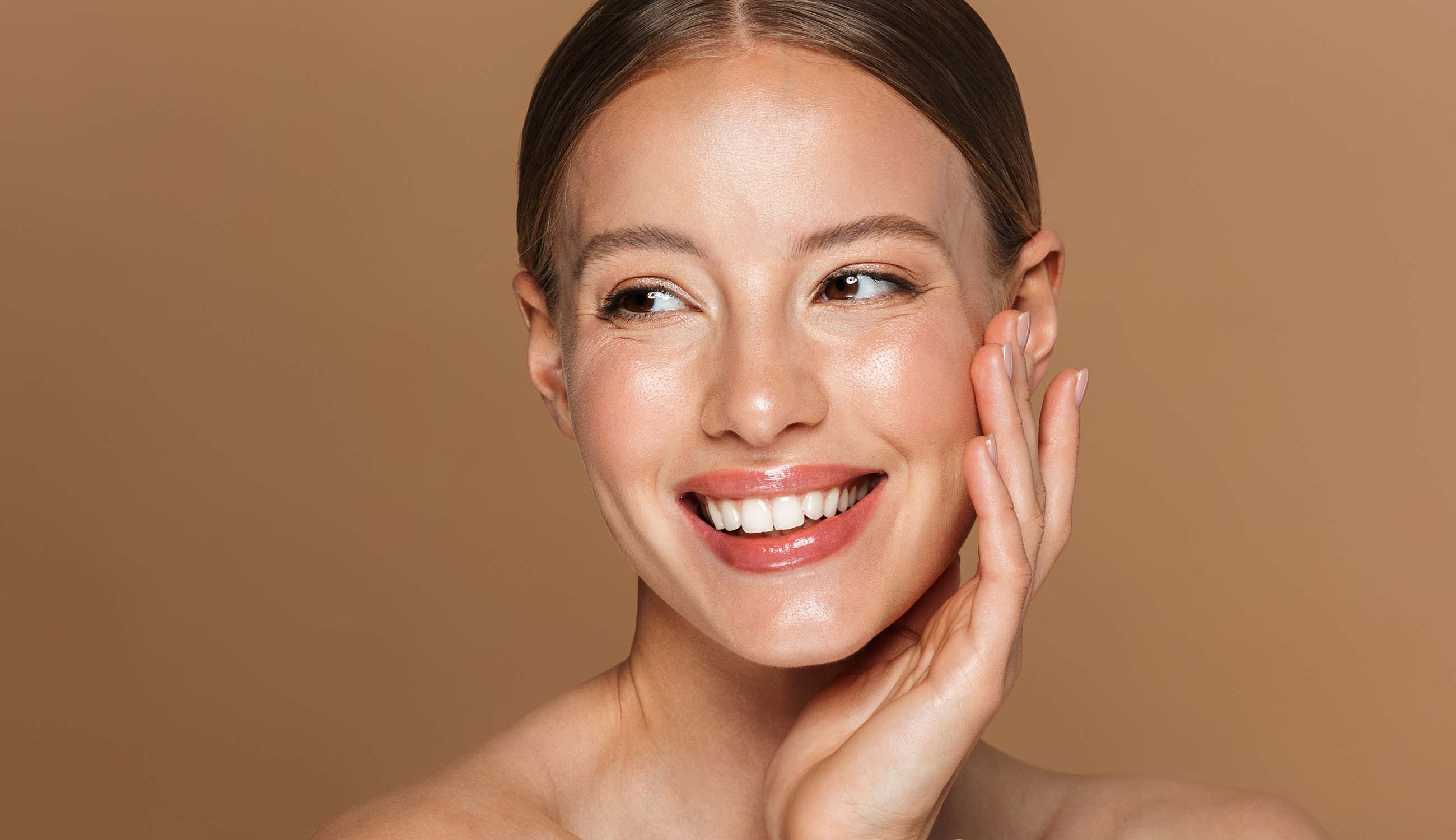
You’ve likely come across the term “Non Comedogenic” on labels of skincare products. Out of the thick and heavy marketing terms in the beauty realm, this one stands out as an essential ally against breakouts, particularly for those with acne-prone or oily skin. But what does this term really mean, and does it guarantee a clear complexion?
Let’s dig deeper into what “comedogenic” and “Non Comedogenic” actually mean, explore the comedogenic scale, and learn how to make better skincare choices to avoid clogged pores and breakouts.
What Do Comedogenic and Non Comedogenic Mean?
Unless you’ve hit the genetic lottery or banned magnifying mirrors from your life, you’ve likely been stuck in a pore dilemma having noticed visible topical changes to the surface of your skin. We’re talking about enlarged pores which, if they become clogged, can be a precursor to a pimple! This is where the importance of non-comedogenic ingredients comes into play – and why you should avoid comedogenic ones at all costs. This is where Non Comedogenic ingredients become crucial for preventing clogged pores.
A “comedo” or “comedone” is the earliest form of acne—a clogged pore. Comedogenic ingredients have a higher likelihood of clogging pores, while Non Comedogenic ingredients are less likely to do so. Products labeled as Non Comedogenic are formulated to minimize the risk of breakouts, making them ideal for those with acne-prone or sensitive skin.
One way to combat any pore-rrific skin issue is to make sure you’re using products with non-comedogenic ingredients, which are less likely to clog your pores. In fact, knowing which ingredients in skincare that tends to clog our pores is how the comedogenic rating was created. This scale helps us make better skincare decisions so we can share some of that genetic lottery, too.
What Is the Comedogenic Scale?
One way to navigate the spectrum of ingredients in skincare products is by the comedogenic scale, which ranks an individual ingredient’s propensity to clog pores. The scale uses a numbering system of 0 to 5 with 2 or less being non-comedogenic or won’t clog pores, and 5 being pore-clogging. Here’s how the numbers rank on the scale:
- 0: Won’t clog pores
- 1: Very low likelihood of clogging pores
- 2: Moderately low likelihood
- 3: Moderate likelihood
- 4: Fairly high likelihood
- 5: High likelihood of clogging pores
Anyone who is susceptible to acne breakouts should avoid highly comedogenic (3-5) ingredients, which we’ll get to below. People with less fussy skin might not have any issues with ingredients with a ranking of 3. But we’d still suggest avoiding the numbers 4 and 5. But remember, the comedogenic scale is not 100% accurate. One individual’s unique skin might not react adversely to a certain ingredient with a propensity to clog pores, whereas another person’s skin does react with the same ingredient. There is no perfect science and since everyone’s skin is different, skincare ingredients will impact different people in different ways.
What Is the Connection Between Comedones and Acne?
Most of us have all kinds of ideas about what causes our breakouts (for example, stress, poor diet, bacteria, and hormones). And while there is truth to that, there’s also a high probability blemishes are caused by one thing, and one thing alone: a plug of oil.
What happens is your skin cells normally shed at the surface, allowing new skin cells to form. Sometimes, dead skin cells and excess oil can get trapped within the hair follicles. When combined with the natural oils in your pores (sebum), a plug can form.
This buildup traps oil underneath it, while the skin above sends the message, ‘hey, I need moisture up here!’ As a result, more and more sebum (oil) builds up, but the plug keeps it trapped. This causes the affected pores to bulge outward, creating comedones or bumps.
This comedonal acne causes bumpy skin and non-inflamed blemishes, as well as whiteheads or blackheads. The names come from how the blemishes look on your skin. They are small bumps that are either flesh-colored or grow into a blackhead, once the head of it has oxidized to a dark brown or black color.
Using Non Comedogenic products like the Multi-Vitamin + Antioxidants Ultra Riché PM Treatment can help prevent comedones by delivering hydration without clogging pores. This treatment is packed with skin-loving vitamins and antioxidants that promote healthy, clear skin.

What Are Some Comedogenic and Non Comedogenic Ingredients?
As we mentioned above, knowing which skincare ingredients that have a high probability – or not – to clog your pores and considering the comedogenic scale puts you on a better path to clear, smooth skin. That’s where we’re here to help – and to help you become an ingredient detective!
When checking product labels, avoid toxic ingredients, like synthetic chemicals, artificial colorants, perfumes, chemical preservatives, BPA, coal tar, phthalates, parabens, formaldehyde, heavy metals, sulfates, talc, and so on. These are comedogenic ingredients and don’t play well on the comedogenic scale. Instead, opt for Non Comedogenic alternatives like lightweight plant-based oils, hyaluronic acid, and aloe vera.
Generally, clean and pure skincare brands will use skin-friendly ingredients that have a low if any likelihood of clogging pores. Look for ingredients or formulas composed of plant, mineral, and/or marine vegetation that undergoes chemical changes due to biological processes such as fermentation, distillation, and cold processing.
Anyone who hesitates to use facial oils or those with acne and oily skin can use non-comedogenic oils if you’re using one suited to your skin type. But it’s important to check that these oils are leaving out the bad stuff. This includes silicones, diluted oils, waxes, dyes, and fragrance. Facial oils can be applied to the skin or used as carriers for things like essential oils. Some of these oils include marula, sunflower, neem, argan, rosehip, and grapeseed oils.
Speaking of the powers of grapes for skin, we like to think of our Intensive Nourishing Facial Oil is a great Non Comedogenic option for those hesitant to use facial oils and is a superhero for oily skin. Featuring a beautiful blend of lightweight grapeseed oil and calming florals and herbs, this ultra-lightweight facial oil truly feeds the skin. What’s great about this oil for oily skin is its grapeseed oil base. Similar in texture and weight to skin’s sebum, this oil sinks in easily and hydrates the skin quickly without clogging pores.
If you have acne-prone and oily skin and you’re still a little on the fence about oils in skincare formulas, the truth is you still need to use moisturizer! Our Tea Tree Balancing Moisturizer is the best face moisturizer for acne-prone skin. It’s designed to properly balance and nourish, without clogging pores or leaving skin feeling greasy. Plus, the tea tree in it is beneficial for acne.
Another Non Comedogenic favorite is the Green Tea SPF 30. Sunscreen is essential for preventing acne scars, but many sunscreens can clog pores. This formula provides broad-spectrum protection while keeping pores clear and skin hydrated.
While you can’t always predict how your skin is going to react to certain ingredients, you can take steps to better prevent comedones and blemishes by sticking to non comedogenic ingredients. Hopefully, with this collection of tips and ingredient ratings, we set you on the path towards a healthier, clearer complexion.
Why Non Comedogenic Products Are Essential for Acne-Prone Skin
For those struggling with acne, the last thing you want is to use skincare products that worsen the problem by clogging pores. Non Comedogenic products are specifically designed to reduce the risk of pore blockages, which can help prevent breakouts and keep your skin looking clear.
Using Non Comedogenic shampoos and conditioners, like the Burdock & Neem Healthy Scalp Shampoo and Conditioner, can also be beneficial for those prone to scalp acne. These products cleanse without stripping natural oils and keep your scalp balanced and healthy.
Non Comedogenic skincare routines help maintain a healthy balance of hydration and oil production, reducing the likelihood of comedonal acne and helping to prevent acne scars over time.
FAQs About Non Comedogenic Skincare
1. Can Non Comedogenic products guarantee no breakouts?
No skincare product can guarantee no breakouts, as everyone’s skin reacts differently to ingredients. However, Non Comedogenic products are less likely to clog pores and cause breakouts, making them a safer choice for acne-prone skin.
2. Are all oils bad for acne-prone skin?
No, some oils are Non Comedogenic and can actually benefit acne-prone skin. Oils like grapeseed, rosehip, and sunflower oil are lightweight and won’t clog pores. Look for Non Comedogenic facial oils like the Intensive Nourishing Facial Oil to keep your skin hydrated without causing breakouts.
3. How can I tell if a product is Non Comedogenic?
Look for the term “Non Comedogenic” on product labels and check the ingredients against the comedogenic scale. Products with ingredients rated 0-2 on the scale are generally considered safe for acne-prone skin.
4. Can sunscreen clog pores?
Some sunscreens can clog pores, especially those with heavy oils or silicones. Choose a Non Comedogenic sunscreen like the Green Tea SPF 30 to protect your skin without causing breakouts.
5. Do I still need to moisturize if I have oily skin?
Yes! Moisturizing is essential for all skin types, even oily skin. Using a Non Comedogenic moisturizer can help balance your skin’s oil production and prevent breakouts. The Multi-Vitamin + Antioxidants Ultra Riché PM Treatment is a great option for nourishing the skin without clogging pores.
Frequently Asked Questions About Non Comedogenic Skincare
How Is the Comedogenic Scale Used to Rate Skincare Products?
The comedogenic scale is a rating system that measures how likely an ingredient or product is to cause comedomes or clog pores and cause acne. It ranges from 0 to 5, with 0 being non-comedogenic - least likely to cause breakouts, and 5 being highly comedogenic - most likely to clog your pores and cause breakouts.
Can Non Comedogenic Products Guarantee No Breakouts?
Just because a product is labeled non comedogenic does not mean it won't cause comedones, it just means it's less likely. One individual’s unique skin might not react adversely to a certain ingredient with a propensity to clog pores, whereas another person’s skin does react with the same ingredient. There is no perfect science and since everyone’s skin is different, skincare ingredients will impact different people in different ways.
Are Non Comedogenic Products Suitable for All Skin Types?
Non comedogenic refers to a skincare product that doesn't contain ingredients that will block or clog pores. While this is a positive for all people and all skin types, it's particularly important for those with oily and acne-prone skin, as well as combination skin, as these are all prone to clogged pores.
What Ingredients Are Commonly Found in Non Comedogenic Products?
Clean and pure skincare brands will use skin-friendly ingredients that have a low if any likelihood of clogging pores. Look for water-based ingredients, like hyaluronic acid and soothing agents like aloe vera, or formulas composed of plant, mineral, and/or marine vegetation that undergoes chemical changes due to biological processes such as fermentation, distillation, and cold processing.
Non comedogenic ingredients also include lighter oils like marula, sweet almond, sunflower, neem, argan, rosehip, and grapeseed oils.
How Important Is It to Choose Non Comedogenic Products for Acne-Prone Skin?
It’s absolutely important! The buildup of dirt, oil, and dead skin cells can lead to clogged pores in the skin. People with oily and acne-prone skin are more likely to have clogged pores. Using non comedogenic skincare products can help to prevent clogged pores and reduce or eliminate acne breakouts.
- Tags: January-2025, Skin Care, skincare
We carefully hand-select products based on strict purity standards, and only recommend products we feel meet this criteria. 100% PURE™ may earn a small commission for products purchased through affiliate links.
The information in this article is for educational use, and not intended to substitute professional medical advice, diagnosis, or treatment and should not be used as such.















